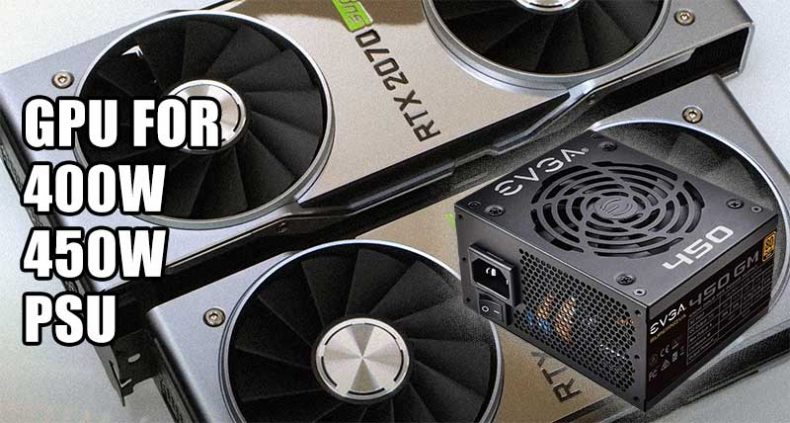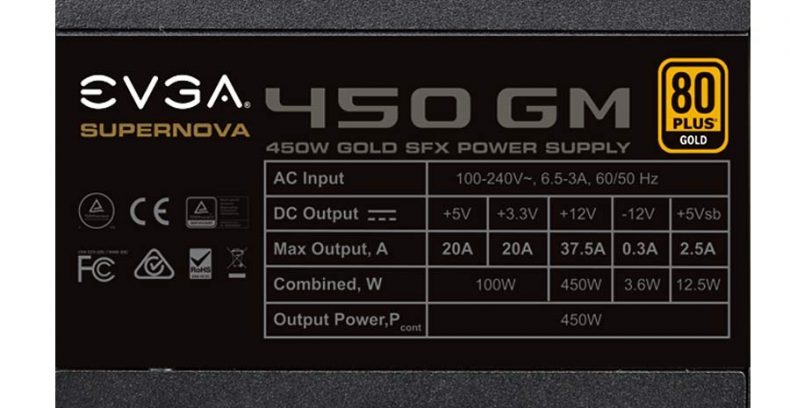Best GPUs for 400W and 450W Power Supply

As a rule of thumb, a high-quality power supply unit (PSU) with a capacity of 400W or 450W is usually sufficient to power GPUs like the Nvidia GeForce RTX 2060 or AMD Radeon RX 6600 XT. However, it’s important to note that not all PSUs are created equal, and a poorly designed PSU with a low amperage rating on the 12V rail can cause system instability or crashes. Thus, it’s highly recommended to opt for a PSU from a reputable manufacturer that can provide consistent and reliable power, with a particular focus on the 12V rail.
To ensure your graphics card gets sufficient and stable power to function optimally, a well-designed PSU with a 12-volt line that can deliver a current of 30 to 37.5 amps is ideal. This ensures that the PSU can supply most of its power on the 12V rail, which is where the graphics card gets its power from. A PSU that can deliver stable power on the 12V rail will prevent the GPU from being underpowered, resulting in poor performance or even damage.
When selecting a PSU, it’s crucial to consider the power requirements of all the components in your PC. Choosing a reliable and high-quality PSU will ensure the longevity and stability of your system, avoiding power-related issues that could result in costly repairs or component replacements.
GPUs that generally considered good match for a quality 400W and 450Wpower supply are:
- NVIDIA RTX 2060 – 400W
- NVIDIA RTX 2070 Super – 450W
- AMD RX 6600 – 400W
- AMD RX 6700 – 450W
The following text will give more details about these models and some of their pros and cons.
NVIDIA RTX 2060
The RTX 2060 is a graphics card designed for gamers and content creators alike, featuring impressive specifications and an affordable price point. In our opinion, it strikes a great balance between performance, power consumption and price, making it a popular choice among budget-conscious PC builders. If you have 400W power supply this is one of the best choices. There are plenty of models on the secondhand market at very affordable prices.
Powered by the Turing architecture and built on TSMC’s 12nm process, the RTX 2060 features a TU106 GPU with 10,800 million transistors and a density of 24.3M/mm², housed in a BGA-2228 chip package. It boasts a base clock of 1365 MHz and a boost clock of 1680 MHz, with 6 GB of GDDR6 memory and a 192-bit memory bus providing a bandwidth of 336.0 GB/s.
With 1920 shading units, 120 TMUs, and 48 ROPs, the RTX 2060 is capable of impressive pixel and texture rates of 80.64 GPixel/s and 201.6 GTexel/s, respectively. It also features 240 Tensor Cores and 30 RT Cores, providing support for real-time ray tracing and AI-enhanced graphics. In our experience, this makes the RTX 2060 a great choice for gaming and content creation tasks.
The RTX 2060 also features a dual-slot board design with a length of 229 mm, a width of 113 mm, and a height of 35 mm. It requires a suggested PSU of 400 W and comes equipped with one 8-pin power connector. It supports multiple output options, including DVI, HDMI 2.0, DisplayPort 1.4a, and USB Type-C.
Overall, the RTX 2060 is a solid choice for gamers and content creators on a budget. With good performance and a reasonable price point, it’s easy to see why it is still a popular choice in the gaming community.
Pros:
- Strong performer at 1440p
- Capable of handling 1080p with ease
- Can do 4K with medium or lower settings for less demanding games
- Good value for the price
- Can handle RTX
- Better power consumption and performance compared to previous generations
Cons:
- Not the best option for 4K gaming as it may struggle with demanding games
- Not the best option for overclocking
- RTX implementation in some games is not well done
NVIDIA RTX 2070 Super
The RTX 2070 Super is based on NVIDIA’s Turing architecture and features 8 GB of GDDR6 memory. The RTX 2070 Super can run modern games at high settings and resolutions with ease. It also supports NVIDIA’s Ray Tracing technology, which can provide a more realistic and immersive gaming experience.
The RTX 2070 Super is powered by the TU104 GPU, which is a 12 nm FinFET chip with 13,600 million transistors. The GPU has 40 SMs, each with 64 CUDA cores, for a total of 2560 CUDA cores. The GPU also has 320 Tensor Cores and 40 RT Cores.
The RTX 2070 Super has 8 GB of GDDR6 memory, which is connected to the GPU via a 256-bit memory bus. The memory runs at 1750 MHz (14 Gbps effective), which provides a memory bandwidth of 448 GB/s.
The RTX 2070 Super has a boost clock speed of 1770 MHz, which is significantly higher than the base clock speed of 1605 MHz. This allows the card to achieve higher frame rates in demanding games.
The RTX 2070 Super has a TDP of 215 W. You can use the GPU with a good quality 450 W power supply.
Pros:
- Excellent performance for its price
- Supports NVIDIA’s Ray Tracing technology
- Supports NVIDIA’s DLSS technology
- Quiet operation
- Efficient cooling
Cons:
- Not as powerful as the RTX 2080 Ti
- Does not have as much VRAM as the RTX 2080 Ti
- Ray Tracing can significantly reduce frame rates
- The card can get quite hot under load
AMD Radeon RX 6600
The RX 6600 is a mid-range graphics card from AMD that was released in August 2021. It is based on the RDNA 2 architecture and features 6GB of GDDR6 memory. The RX 6600 is designed to compete with NVIDIA’s GTX 1660 Super and RTX 2060.
Overall, the RX 6600 is a great option for gamers who are looking for a mid-range card that can offer good performance at a reasonable price. It is also very power efficient, which can save gamers money on their power bill. However, the RX 6600 does not have a lot of VRAM and does not support Ray Tracing.
The GPU is manufactured by TSMC using a 7 nm process, with a total of 11,060 million transistors packed into a die size of 237 mm², resulting in a density of 46.7M transistors per mm². The chip package is BGA-1269.
The RX 6600 has a base clock speed of 1626 MHz, a game clock of 2044 MHz, and a boost clock of 2491 MHz. It has 8 GB of GDDR6 memory with a 128-bit memory bus, operating at a memory clock speed of 1750 MHz (14 Gbps effective), providing a memory bandwidth of 224.0 GB/s.
The theoretical performance of the RX 6600 is as follows: a pixel rate of 159.4 GPixel/s, a texture rate of 279.0 GTexel/s, an FP16 (half) performance of 17.86 TFLOPS (2:1), an FP32 (float) performance of 8.928 TFLOPS, and an FP64 (double) performance of 558.0 GFLOPS (1:16).
In terms of its board design, the RX 6600 is a dual-slot card with a length of 190 mm (7.5 inches), a width of 110 mm (4.3 inches), and a height of 40 mm (1.6 inches). It has a total power draw (TDP) of 132 W and requires a suggested power supply unit (PSU) of 300 W. The GPU is equipped with 1x HDMI 2.1 and 3x DisplayPort 1.4a outputs and requires a single 8-pin power connector. The board number for this GPU model is D532.
Here are the pros and cons of the RX 6600:
Pros:
- Good performance
- Affordable price
- Power efficient
Cons
- Not a lot of VRAM
- Does not support Ray Tracing
AMD Radeon RX 6600 XT
The RX 6600 XT is a mid-range graphics card from AMD that was released in August 2021. It is based on the RDNA 2 architecture and features 8GB of GDDR6 memory. The RX 6600 XT is designed to compete with NVIDIA’s GTX 1660 Ti and RTX 2060.
Тhe RX 6600 XT is a graphics processor based on the RDNA 2.0 architecture. It belongs to the Navi II (RX 6000) generation and is the successor to the Navi GPU. Manufactured by TSMC using a 7 nm process, the RX 6600 XT has 11,060 million transistors and a density of 46.7M transistors per mm². The GPU variant is Navi 23 XT, and it comes in a BGA-1269 chip package.
The RX 6600 XT was released on July 30th, 2021, with availability starting on August 10th, 2021. It is currently in active production. The initial launch price for the GPU was 379 USD, but the current price may vary and can be found on platforms like Amazon and Newegg. There are 45 reviews of this GPU in the database.
In terms of clock speeds, the RX 6600 XT has a base clock of 1968 MHz, a game clock of 2359 MHz, and a boost clock of 2589 MHz. The GPU is equipped with 8 GB of GDDR6 memory operating at a memory clock speed of 2000 MHz (16 Gbps effective). It utilizes a 128-bit memory bus, providing a memory bandwidth of 256.0 GB/s.
The rendering configuration of the RX 6600 XT includes 2048 shading units, 128 texture mapping units (TMUs), and 64 render output units (ROPs). It features 32 compute units and 32 RT cores for ray tracing. The GPU has a 32 KB L0 cache per WGP, a 128 KB L1 cache per array, a 2 MB L2 cache, and a 32 MB L3 cache.
The theoretical performance of the RX 6600 XT is as follows: a pixel rate of 165.7 GPixel/s, a texture rate of 331.4 GTexel/s, an FP16 (half) performance of 21.21 TFLOPS (2:1), an FP32 (float) performance of 10.60 TFLOPS, and an FP64 (double) performance of 662.8 GFLOPS (1:16).
The board design of the RX 6600 XT is a dual-slot card with a length of 190 mm (7.5 inches), a width of 110 mm (4.3 inches), and a height of 40 mm (1.6 inches). It has a total power draw (TDP) of 160 W and requires a suggested power supply unit (PSU) of 450 W. The GPU is equipped with 1x HDMI 2.1 and 3x DisplayPort 1.4a outputs and requires a single 8-pin power connector. The board number for this GPU model is D532.
Pros
- Good performance at 1080p
- Competitive price
- Power efficient
- Quiet operation
Cons
- Limited VRAM
- Does not support Ray Tracing
- Not as good as NVIDIA’s RTX 2060 at 1440p and 4K
Overall, the RX 6600 XT is a good option for gamers who are looking for a mid-range card that can offer good performance at 1080p. However, it is not as good as NVIDIA’s RTX 2060 at 1440p and 4K, and it does not support Ray Tracing.
Allan Witt
Allan Witt is Co-founder and editor in chief of Hardware-corner.net. Computers and the web have fascinated me since I was a child. In 2011 started training as an IT specialist in a medium-sized company and started a blog at the same time. I really enjoy blogging about tech. After successfully completing my training, I worked as a system administrator in the same company for two years. As a part-time job I started tinkering with pre-build PCs and building custom gaming rigs at local hardware shop. The desire to build PCs full-time grew stronger, and now this is my full time job.Related
Desktops
Best GPUs for 600W and 650W PSU
A high-quality 500W PSU is typically sufficient to power GPUs like the Nvidia GeForce RTX 370 Ti or RTX 4070.
Guides
Dell Outlet and Dell Refurbished Guide
For cheap refurbished desktops, laptops, and workstations made by Dell, you have the option…
Guides
Dell OptiPlex 3020 vs 7020 vs 9020
Differences between the Dell OptiPlex 3020, 7020 and 9020 desktops.

